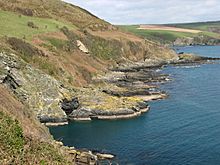Polruan to Polperro facts for kids
| Site of Special Scientific Interest | |

Coastline to the east of the SSSI
|
|
| Area of Search | Cornwall |
|---|---|
| Coordinates | 50°19′57″N 4°35′16″W / 50.3325°N 4.5877°W |
| Interest | Biological |
| Area | 213.4 hectares (2.13 km2; 0.824 sq mi) |
| Notification | 1951 |
The Polruan to Polperro area is a very special part of the coast in south-east Cornwall, England. It's officially called a Site of Special Scientific Interest (SSSI) and a Special Area of Conservation (SAC). This means it's super important for its amazing plants and animals. It has many different types of plants and is a home for lots of breeding birds.
Contents
Exploring the Polruan to Polperro Coast
This special coastal area covers about 213.5 hectares. That's like 527 football fields! It was first recognized as important in 1951. You can find it on the south-east coast of Cornwall, right next to the English Channel. It's about 2 miles (3 km) east of the town of Fowey.
The area starts near the fishing village of Polruan in the west. It then stretches all the way to the fishing harbour and village of Polperro in the east. All of this beautiful coastline is within the local areas of Lanteglos and Lansallos.
A famous walking trail called the South West Coast Path goes right through this protected site. Most of the coastline here is looked after by the National Trust, an organization that protects special places.
Amazing Wildlife and Nature
This coastal area is home to many different types of natural environments, called habitats. These include shingle beaches, grassy areas near the sea, scrubland (areas with small bushes), old farm fields, and various cliff areas. Because of this, it's considered an "Important Plant Area" by Plantlife, a charity that protects wild plants.
Coastal Plants: Flora
The shingle beaches here have some very rare plants. These plants are not found in many other places in Cornwall or even the rest of the UK. Some examples include Babington's orache, Ray’s knotgrass, sand couch, sea bindweed, sea kale, sea spurge, and sea sandwort.
Along the cliffs, in rocky cracks, you can find other special plants. These include the nationally scarce ivy broomrape, lanceolate spleenwort, and maidenhair fern. You can also spot different types of calcicole (plants that like lime-rich soil) and lichen (a type of fungus and algae living together).
The grassy areas near the sea have lots of red fescue grass. You can also find this grass in rocky cracks and ledges. Other well-kept grassy spots have plants like common bent, common bird's-foot trefoil, common cat's-ear, common dog-violet, common milkwort, common knapweed, common restharrow, ribwort plantain, sweet vernal-grass, yarrow, woodrush, wild thyme, and Yorkshire fog.
Two other nationally scarce plants, slender bird's-foot trefoil and hairy bird's-foot trefoil, also grow in these grassy areas. There are also large areas of natural grassland that haven't been changed by farming. These grasslands have a huge variety of plant species and are very rare for Cornwall and the UK.
Coastal Animals: Fauna
This site is home to many invertebrates (animals without backbones), including some rare ones. You might spot the beautiful scarlet tiger moth or the nationally scarce pearl-bordered fritillary butterfly. In the grassy fields, you can also find the scarce hornet robberfly.
The cliffs and coastal areas are also important for many breeding birds. Two special birds listed in the Red Data Book (which lists species at risk) have been seen here: the Dartford warbler and the powerful peregrine falcon.

